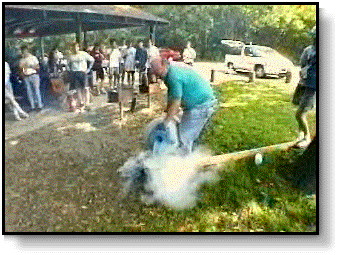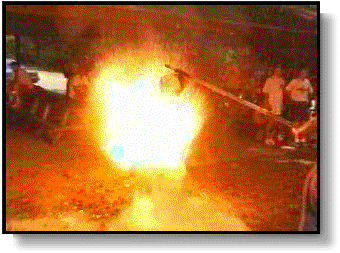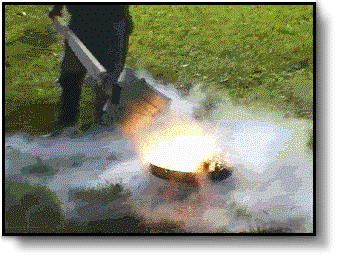

Warning: The content of this issue’s How To article is a report about the actions of a highly trained individual. In no way are we suggesting the described events as a proper course of action for those untrained in the use of the agents involved. Liquid Oxygen is a very dangerous substance, and should not be handled by those not fully trained in its use. Lets just all sit back and watch the Pros play.
by John Haley
Over the past year, the How To column has served us well as a tool to let our users know how to tweak the most out of Ambrosia’s products. For September’s issue, I have decided to stray away from our own products, and illustrate how one particular individual tackles a problem that has plagued us all.
Labor Day is upon us, and to me labor day means Barbecue. For our friends overseas, who may not be familiar with the holiday, a brief synopsis of Labor Day is in order. Labor Day is a holiday set aside for the working class, the average Joe or Jane that gets up at the crack of dawn and shuffles off to work to make an honest buck. One day set aside each year that folks can stay home and relax.
Grilling has become a Labor Day tradition. Before “work” was invented, mankind lived an idyllic, peaceful lifestyle inside caves. The creation and maintenance of fire was an important part of his existence. Prehistoric man used fire to cook food, heat the cave, ward off predators and attract prehistoric babes (face it, a man with a cold cave is not a good date).
So as a reminder of these simpler times, we barbecue on Labor Day. Since prehistoric times, grilling technology has not advanced as far as other sciences. Early man relied on wood. A hearty fuel, wood comes in many shapes and sizes, ranging from the mighty oak to your neighbor’s deck (if you take every other spindle off of the railing, he really isn’t going to notice). Besides burning a little too quickly, wood doesn’t provide modern man with the challenge he seeks. In the 20th Century, man has advanced to gas grills. The basic concept of turning a rocket upside down to cook meals appeals to the inventive side of the male brain. But there is little satisfaction to be had by simply hitting a switch and having the grill ready to cook. Might as well simply remove the roof off of your kitchen.
In between these two techniques there is coal. Coal is a truly manly fuel. It is not gathered in the woods like wildflowers, and it is not a domesticated fuel used for indoor cooking, like gas. Coal has to be ripped out of the earth, requiring intensive labor and large noisy machines, usually painted yellow. Then it has to be shipped to market on trains or barges and carried in large trucks. Ah. Just the thought of it kindles a manly glow in my heart (or was that the chili dog I ate for breakfast?).
After all this, coal finally reaches you and the true challenge begins. This is where modern man can share in the frustrations of his prehistoric ancestors. Lighting a rock on fire is an unnatural act. Coal must be coerced into accepting the flame. The process of actually igniting the coal, and having them turn from their natural black to a cheery “throw the steak on” gray can be a lengthy one. Lucky for the rest of us, there are a few dedicated scientists hard at work on reducing the time between lighting the fire and cooking the food.
George Goble, a senior systems engineer at Purdue University, has successfully reduced the ignition-to-cooking time to a mere three seconds. That’s right three seconds. Less time than it takes to open a beer can with your front teeth. And if you happen to have several gallons of Liquid Oxygen on hand, and are in a hurry to get some great grilled food, give George a call.

Liquid Oxygen, an extremely dangerous substance, is poured into a bucket on the end of a long wooden pole. You really do not want to be around ground zero when this baby is lit. Liquid Oxygen is pale blue in color, and slightly magnetic.

The bucket of Liquid Oxygen is then poured over the charcoal in the grill. One lit coal, or a cigarette is needed to start the reaction. Pouring Liquid Oxygen onto unlit charcoal will cause the charcoal to explode; each briquette will detonate with the force of one stick of dynamite. This is not something you want to spill on your driveway.
The resulting fireball “blinds” the camera. The above pictures are from a single video taken by Joe Cychosz and Jeff Sponaugle , the flash has caused one exposure to seem like it is dark out, but actually only a few minutes have passed.

Hope you’re hungry, because it looks like we’ll be eating real soon. This little grill is white hot! The only problem now is getting dinner cooked before the bottom of the grill burns through. Maybe they should get a hold of some of those space shuttle tiles that are always falling off. I wonder if NASA is having a post-woodpecker sale on pre-enjoyed space shuttle thermal shield tiles.
Ambrosia managed to track down George Goble and ask him a few questions about this pioneering Liquid Oxygen BBQ technique.

Ambrosia Times: Hello George, thank you for taking the time to answer some questions. Some of us consider your reduction of grilling time a contribution to mankind right up there with the twist off soda cap. What prompted you to develop this time saving method, and was it your first attempt at speeding up the BBQ process?
George Goble: Just something neat to do. It started with hair driers and vacuum cleaners (in blow), progressed to propane, acetylene torches, flight oxygen (gas), [that took 30 sec to light], and finally LOX for a 3 sec (or maybe even 2) ignition.
Ambrosia Times: Great, all in the name of science and good fun. I checked my BBQ aisle in the local supermarket, and they seemed to be fresh out of liquid oxygen. I thought the local stop + rob convenience store would have it, at a marked up price, but they were out too. Is LOX commonly available?
George Goble: At hospitals and Welding Supply houses. It is usually not sold to individuals in the fear they may incinerate themselves and their families.
Ambrosia Times: I guess inviting everyone over for a family reunion, and than incinerating half of them, would not be a good move. All of us at some time have experienced that embarrassing “flame follows the lighter fluid back into the can, so throw it into the neighbor's yard” problem. Does Liquid Oxygen have any quirks we should know about, besides making a pile of briquettes the equivalent of a car bomb?
George Goble: LOX may detonate if spilled on asphalt. If spilled out of the grill (cold gas/LOX is heavy) onto the ground which has grass (even wet) there will also be an expanding fireball on the ground as the grass and anything organic burns/vaporizes for about a 10 foot radius. It leaves just clear dirt, no “ash” or carbon.
A large bathtub full of LOX (better do this outside) would “vaporize” a body, no burial or cremation hassles. Toss in the body, and flip in a lit cigarette from a distance. Go out with a bang/flash. No mess left, no ashes.
Ambrosia Times: Well, I guess we don’t have to speculate on the whereabouts of any x-wives or your daughter’s missing boyfriends.
Some companies are marketing BBQ in a bag, where the bag itself is soaked in flammable material and you just have to put a match to it. Do you have any plans for a similar product involving your method? I think this would be popular among back yard BBQ'ers and terrorists alike.
George Goble: Now that the Grateful Dead — is, there should be plenty of “nitrous” tanks available (full). Nitrous should start a grill in 10-15 sec, plus nitrous needs no refrigeration like LOX does. Nitrous also has a long shelf life and can be stored for years (if you can keep people from inhaling it).
Ambrosia Times: Sounds like it is more portable too. I see a whole new market opening up with campers. I can not begin to tell you how many times I’ve been huddled over some damp twigs willing them to catch fire.
I like to keep my cooking utensils right near the grill. Is this still a good idea, or will the blast radius result in my hot dog forks being stuck in the neighbors garage wall?
George Goble: Just don't presoak the briquettes with LOX or the forks may stick on the inside of your neighbors far wall, after passing through you first. Your
hot dogs/hamburgers may end up on the moon.
Ambrosia Times: Yikes. Well on that note, we’ll sign off. Thanks once again George for taking the time to chat with us about backyard incineration methods. It’s been a pleasure.

